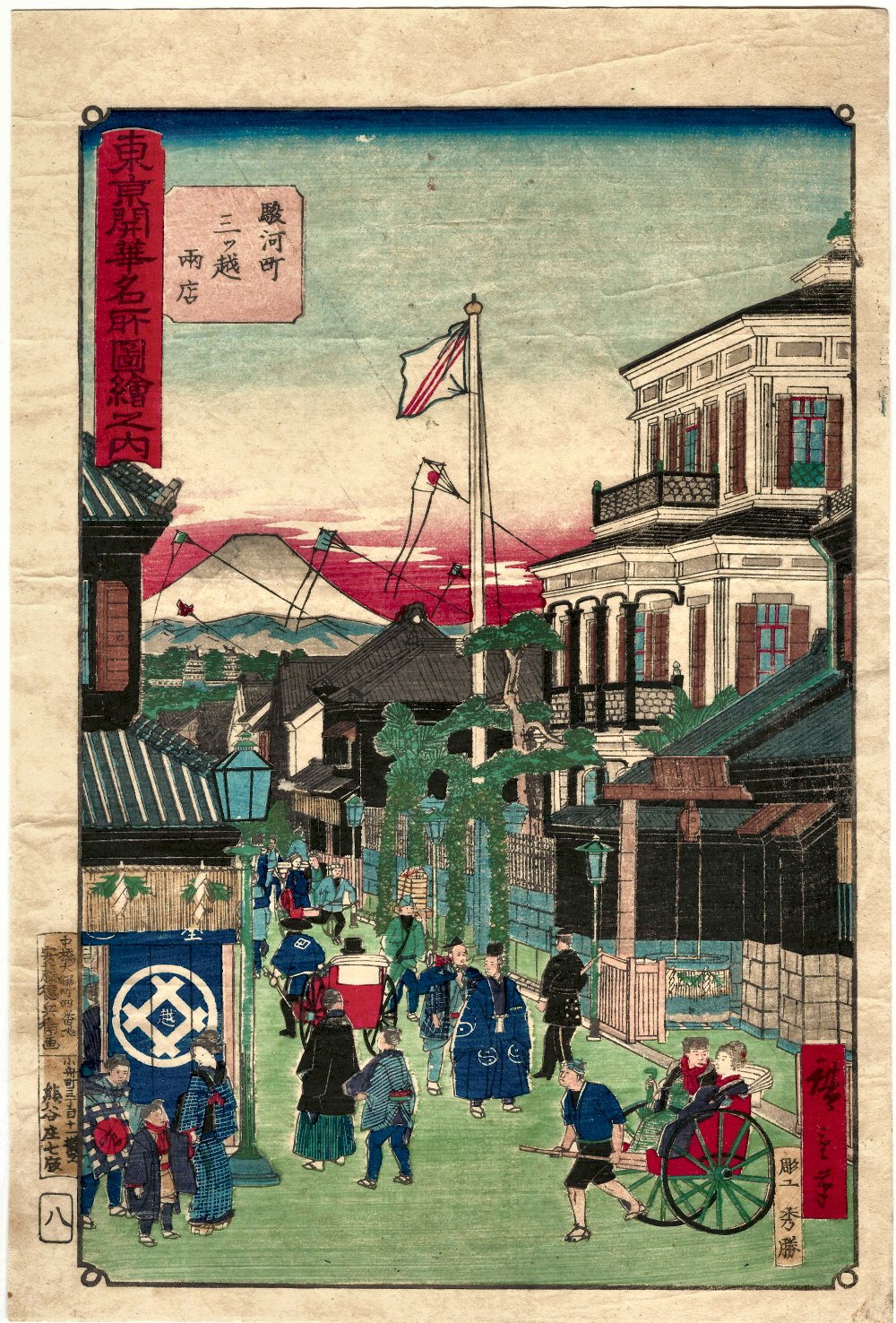| |
Hiroshige IIIShigemasa (1843 - 1894)"The Mitsukoshi Department Store in Suruga-cho" |

"The Mitsukoshi Department Store
in Suruga-cho"
("駿河町三井銀行")
Series: "Illustrated guide to famous places
in Tokyo"
(Tōkyō Hiraki hana meisho zue no uchi, 東京開華名所図会之内)
1876
Comment - View of the 'Echigoya
Kimono and Drapery Store' with noren shop curtains
representing Mitsukoshi (left, blue noren with white sharp
musical symbol, ♯). Both Mitsukoshi buildings appear in the
foreground on either side of the street. The Western-style
building (center right) is belonging to the 'Mitsui-gumi
Exchange Bank' ('為替バンク三井組'), completed in 1874. Later, until
today, it became the place of the 'Bank of Japan' (built in
1896). Mount Fuji is rising majestically in the background.
This scene of the Suruga District captures a lively view of
city life. Suruga-cho is a district just north of Nihonbashi
Bridge in what is now called Muromachi san-chome. The name of
the area where Mt. Fuji is located was at the time called
Suruga (駿河国, Suruga no kuni; present day Shizuoka
Prefecture), which is why the name for this district was
Suruga-cho until 1932. An existing photo
of the scene is from Meiji 10 (1877).
Mitsukoshi is one of the great success stories in Japanese business and was unique in its time for demanding cash payment at the time of purchase instead of the traditional accounting system requiring payment over a period of time, often after harvest. The cross street in the foreground shows a rickshaw with two passengers, heading for the left Mitsukoshi Store building. In front of the left Mitsukoshi Store stands a lady and two children, one of the boys is carrying an edo kaku kite with a variation of the flag of Japan. The street is leading to Edo Castle and Mt. Fuji in the far background. The scene depicts the hustle and bustle of Suruga-cho. Note the Western style gas lanterns. Dusk may be arriving, with red clouds in the background, and a blue sky above, both with delicate bokashi shading. Four edo kaku kites, and a Yakko kite ("yakko dako", "奴凧") are roaming the tranquil evening sky. One of the edo kaku kites carries the Japanese flag.
Different kinds of Mitsui enterprises have been depicted in kite woodblock prints by Hiroshige-III (see above), Hokusai, and Kuniyoshi. Please refer to the "Keyword Glossary" in the addenda for "Mitsui Clan". Even this street scene has been depicted by Hiroshige-III from different angles and particular views. But only this print and HIROSHIGE-III's "The Mitsui Bank in Suruga-cho" contain kites.
The series title is in the vertical rectangular red cartouche upper left. The title whiteish carouche shows the title of the print (literally "駿河町 三ッ越 雨店", "Suruga-cho Mitsukoshi RainShop"). This print is number "八" in the series (Chinese number "eight" (hachi, "八", below the Editor's cassette).
Series - Illustrated guide to famous places in Tokyo (short: 'Tokyo Kaika Meisho' or Tōkyō Hiraki hana meisho zue no uchi, 東京開華名所図会之内)
Artist - see Biography
Signature - "Hiroshige hitsu" ("広重筆") in red cassette at lower right, next to the yellowish carvers seal adjacent (Hori e Muneoka, 彫エ 宗岡)
Publisher - KUMAGAI Shōshichi ( 熊谷庄七) von Ebisuya Publishers (Ebisu-ya Shoshichi, 恵比寿屋庄七)
Image Size - 24.8cm x 37.1cm. (9 3/4" x 145/8")
Condition - Woodblock print (nishiki-e); ink and color on paper, single sheet, Vertical ôban; Tate-e (portrait);
Mitsukoshi is one of the great success stories in Japanese business and was unique in its time for demanding cash payment at the time of purchase instead of the traditional accounting system requiring payment over a period of time, often after harvest. The cross street in the foreground shows a rickshaw with two passengers, heading for the left Mitsukoshi Store building. In front of the left Mitsukoshi Store stands a lady and two children, one of the boys is carrying an edo kaku kite with a variation of the flag of Japan. The street is leading to Edo Castle and Mt. Fuji in the far background. The scene depicts the hustle and bustle of Suruga-cho. Note the Western style gas lanterns. Dusk may be arriving, with red clouds in the background, and a blue sky above, both with delicate bokashi shading. Four edo kaku kites, and a Yakko kite ("yakko dako", "奴凧") are roaming the tranquil evening sky. One of the edo kaku kites carries the Japanese flag.
Different kinds of Mitsui enterprises have been depicted in kite woodblock prints by Hiroshige-III (see above), Hokusai, and Kuniyoshi. Please refer to the "Keyword Glossary" in the addenda for "Mitsui Clan". Even this street scene has been depicted by Hiroshige-III from different angles and particular views. But only this print and HIROSHIGE-III's "The Mitsui Bank in Suruga-cho" contain kites.
The series title is in the vertical rectangular red cartouche upper left. The title whiteish carouche shows the title of the print (literally "駿河町 三ッ越 雨店", "Suruga-cho Mitsukoshi RainShop"). This print is number "八" in the series (Chinese number "eight" (hachi, "八", below the Editor's cassette).
Series - Illustrated guide to famous places in Tokyo (short: 'Tokyo Kaika Meisho' or Tōkyō Hiraki hana meisho zue no uchi, 東京開華名所図会之内)
Artist - see Biography
Signature - "Hiroshige hitsu" ("広重筆") in red cassette at lower right, next to the yellowish carvers seal adjacent (Hori e Muneoka, 彫エ 宗岡)
Publisher - KUMAGAI Shōshichi ( 熊谷庄七) von Ebisuya Publishers (Ebisu-ya Shoshichi, 恵比寿屋庄七)
Image Size - 24.8cm x 37.1cm. (9 3/4" x 145/8")
Condition - Woodblock print (nishiki-e); ink and color on paper, single sheet, Vertical ôban; Tate-e (portrait);
Copyright 2008 ff: Hans P. Boehme